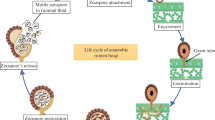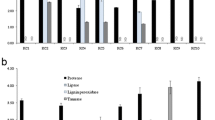Abstract
In the present study, anaerobic fungi were isolated from different ruminants and non-ruminants; i.e., cattle, buffalo, sheep, goats, wild bluebulls, elephants, deer, and zebras; and were identified as Anaeromyces, Orpinomyces, Caecomyces, Piromyces, and Neocallimastix sp., based on their morphological characteristics. These isolates possessed significant in vitro hydrolytic enzyme activities; however, an isolate of Caecomyces sp. from elephant was found to exhibit maximum activity, i.e., filter paper cellulase (Fpase; 21.4 mIU/ml), carboxymethyl cellulose (CMCase; 15.1 mIU/ml), cellobiase (37.4 mIU/ml), and xylanase (26.0 mIU/ml). Besides, this isolate also showed the significantly highest ability to digest plant cell-wall contents in vitro. The in vitro dry matter digestibility increased from 45.1 to 48.9% after 48 h of incubation, and the plant cell-wall contents, in terms of neutral detergent fiber and acid detergent fiber, decreased from 64.2 to 61.3% and from 31.3 to 29.6%, respectively. These results indicate that such fibrolytic ruminal fungal strains are prevalent in wild herbivores such as elephants, as well as in other ruminants and non-ruminants, and could be exploited as microbial feed additives for improved nutrition and productivity in domesticated ruminants.




Similar content being viewed by others
References
Akin DE, Benner R (1988) Degradation of polysaccharides and lignin by ruminal bacteria and fungi. Appl Environ Microbiol 54:1117–1125
Akin DE, Rigsby LL (1987) Mixed fungal populations and lignocellulosic tissue degradation in the bovin rumen. Appl Environ Microbiol 53:1987–1995
AOAC (1995) Association of Official Analytical Chemists: official methods of analysis, 16th edn. AOAC International, Arlington, Virginia, pp 1–29
Barichievich EM, Calza RE (1990) Supernatant protein and cellulase activities of the anaerobic ruminal fungus Neocallimastix frontalis EB188. Appl Environ Microbiol 56:43–48
Barnett AJG, Reid RL (1957) Studies on the production of volatile fatty acids from the grass by rumen liquor in an artificial rumen. J Agric Sci 48:315–321
Barr DJS, Kudo H, Jakober KD, Cheng KJ (1989) Morphology and development of rumen fungi: Neocallimastix sp, Piromyces communis, and Orpinomyces bovis gen nov, sp. nov. Can J Bot 67:2815–2824
Bauchop T (1979) Rumen anaerobic fungi of sheep and cattle. Appl Environ Microbiol 38:148–158
Bauchop T, Mountfort DO (1981) Cellulose fermentation by a rumen anaerobic fungus in both the absence and presence of rumen methanogens. Appl Environ Microbiol 42:1103–1110
Borneman WS, Ljungdahl LG, Hartley RD, Akin DE (1992) Purification and partial characterization of two feruloyl esterases from the anaerobic fungus Neocallimastix strain MC2. Appl Environ Microbiol 58:3762–3766
Bradford MM (1976) A rapid and sensitive method for the quantitation of microgram quantities of protein utilizing the principle of protein-dye binding. Anal Biochem 72:248–254
Breton A, Bernalier A, Bonnemoy F, Fonty G, Gaillard B, Gouet P (1989) Morphological and metabolic characterization of a new species of strictly anaerobic rumen fungus: Neocallimastix joyonii. FEMS Microbiol Lett 58:309–314
Breton A, Bernalier A, Dusser M, Fonty G, Gaillard-Martinie B, Guillot J (1990) Anaeromyces mucronatus nov. gen., nov. sp.: a new strictly anaerobic rumen fungus with polycentric thallus. FEMS Microbiol Lett 70:177–182
Brookman JL, Ozkose E, Rogers S, Trinci APJ, Theodorou MK (2000) Identification of spores in the polycentric anaerobic gut fungi which enhance their ability to survive. FEMS Microbiol Ecol 31:261–267
Chen H, Li X, Ljungdhal LG (1994) Isolation and properties of an extracellular β-glucosidase from the polycentric rumen fungus Orpinomyces sp. strain PC-2. Appl Environ Microbiol 60:64–70
Chen YC, Tsai SD, Cheng HL, Chien CY, Hu CY, Cheng TY (2007) Caecomyces sympodialis sp. nov., a new rumen fungus isolated from Bos indicus. Mycologia 99:125–130
Davies DR, Theodorou MK, Lawrence MIG, Trinci APJ (1993) Distribution of anaerobic fungi in the digestive tract of cattle and their survival in feces. J Gen Microbiol 139:1395–1400
Dayanand TL, Nagpal R, Puniya AK, Sehgal JP, Singh K (2007) In vitro degradation of urea-NH3 treated wheat straw using anaerobic ruminal fungi. J Anim Feed Sci 16:484–489
Dey A, Sehgal JP, Puniya AK, Singh K (2004) Influence of an anaerobic fungal culture (Orpinomyces sp.) administration on growth rate, ruminal fermentation and nutrient digestion in calves. Asian Ausralas J Anim Sci 17:820–824
Goering HK, VanSoest PJ (1970) Forage fibre analysis. Agricultural Handbook No.379. USDA, Washington, DC
Gold JJ, Heath IB, Bauchop T (1988) Ultrastructural description of a new chytrid genus of caecum anaerobe, Caecomyces equi gen. nov. sp. nov, assigned to the Neocallimasticaceae. Biosystems 21:403–415
Ho YW, Barr DJS, Abdullah N, Jalaludin S, Kudo H (1993a) A new species of Piromyces from the rumen of deer in Malaysia. Mycotaxon 47:285–293
Ho YW, Barr DJS, Abdullah N, Jalaludin S, Kudo H (1993b) Neocallimastix Variabilis, a new species of anaerobic rumen fungus from cattle. Mycotaxon 46:241–258
Hungate RE (1969) A roll-tube method for cultivation of strict anaerobes. Methods Microbiol 3B:117–132
Joblin KN (1981) Isolation, enumeration and maintenance of rumen anaerobic fungi in roll-tubes. Appl Environ Microbiol 42:1119–1122
Kawaminami T, Izuka H (1970) Studies on xylanase from microorganisms. IV. Action of xylanase of Chaetomium trilaterate strain No. 2264 upon xylan. J Ferment Technol 48:161–168
Kostyukovsky VA, Okunev ON, Tarakanov BV (1990) Anaerobic cellulolytic fungi from cattle rumen. Mikrobiologia 59:1067–1074
Lee SS, Choi CK, Ahn BH, Moon YH, Kim CH, Ha JK (2004) In vitro stimulation of rumen microbial fermentation by a rumen anaerobic fungal culture. Anim Feed Sci Technol 115:215–226
Li JI, Heath IB, Bauchop T (1990) Piromyces mae and Piromyces dumbonica, two new species of uniflagellate anaerobic chytridiomycete fungi from the hindgut of the horse and elephant. Can J Bot 68:1021–1033
Li JI, Heath IB, Cheng KJ (1991) The development and ultrastructure of a polycentric chytridiomycete gut fungus, Orpinomyces joyonii comb. nov. Can J Bot 69:580–589
Mandels M, Andreotti R, Roche C (1976) Measurement of saccharifying cellulase. Biotechnol Bioeng Symp 6:21–23
Manikumar B, Puniya AK, Singh K, Sehgal JP (2004) In vitro degradation of cell wall and digestibility of cereal straws treated with anaerobic ruminal fungi. Indian J Exp Biol 42:636–638
Miller GL (1959) Use of dinitrosalicylic acid reagent for determination of reducing sugars. Anal Chem 31:426–428
Mountfort DO, Asher RA (1989) Production of xylanase by the ruminal anaerobic fungus Neocallimastix frontalis. Appl Environ Microbiol 55:1016–1022
Nagpal R, Puniya AK, Singh K (2009) In vitro fibrolytic activities of the anaerobic fungus. Caecomyces sp., immobilized in alginate beads. J Anim Feed Sci 18:758–768
Orpin CG (1975) Studies on the rumen flagellate Neocallimastix frontalis. J Gen Microbiol 91:249–262
Orpin CG, Joblin KN (1988) The rumen anaerobic fungi. In: Hobson PN (ed) The rumen microbial ecosystem. Elsevier Applied Science, London, pp 129–150
Paul SS, Kamra DN, Sastry VRB, Agarwal N (2004a) Effect of administration of an anaerobic gut fungus isolated from wild blue bull to buffaloes on in vivo ruminal fermentation and digestion of nutrients. Anim Feed Sci Tech 115:143–157
Paul SS, Kamra DN, Sastry VRB, Sahu NP, Agarwal N (2004b) Effect of anaerobic fungi on in vitro feed digestion by mixed rumen microflora of buffalo. Reprod Nutr Dev 44:313–319
Sehgal JP, Jit D, Puniya AK, Singh K (2008) Influence of anaerobic fungal administration on growth, rumen fermentation and nutrient digestion in female buffalo calves. J Anim Feed Sci 17:510–518
Snedecor GW, Cochran WG (1980) Statistical methods, 7th edn. The Iowa State University Press, Ames, USA
Srinivasan K, Murakami M, Nakashimada Y, Nishio N (2001) Efficient production of cellulolytic and xylanolytic enzymes by the rumen anaerobic fungus, Neocallimastix frontalis in a repeated batch culture. J Biosci Bioeng 91:153–158
Teunissen MJ, De Kort GVM, Op den Camp HJM, Vogels GD (1993) Production of cellulolytic and xylanolytic enzymes during growth of anaerobic fungi from ruminant and non-ruminant herbivores on different substrates. Appl Biochem Biotech 39:177–189
Thareja A, Puniya AK, Goel G, Nagpal R, Sehgal JP, Singh P, Singh K (2006) In vitro degradation of wheat straw by anaerobic fungi from small ruminants. Arch Anim Nutr 60:412–417
Tilley JMA, Terry RA (1963) A two-stage technique for the in vitro digestion of forage crops. J Br Grassland Soc 18:104–111
Trinci APJ, Davies DR, Gull K, Lawrence MI, Bonde-Nielsen B, Rickers A, Theodorou MK (1994) Anaerobic fungi in herbivorous animals. Mycol Res 98:129–152
Tripathi VK, Sehgal JP, Puniya AK, Singh K (2007a) Hydrolytic activities of anaerobic fungi from wild blue bull (Boselaphus tragocamelus). Anaerobe 13:36–39
Tripathi VK, Sehgal JP, Puniya AK, Singh K (2007b) Effect of administration of anaerobic fungi isolated from cattle and wild blue bull (Boselaphus tragocamelus) on growth rate and fibre utilization in buffalo calves. Arch Anim Nutr 61:416–423
Yanke LJ, Dong Y, McAllister TA, Bae HD, Cheng KJ (1993) Comparison of amylolytic and proteolytic activities of ruminal fungi grown on cereal grains. Can J Microbiol 39:817–820
Acknowledgments
The authors express thanks for the research fellowships and funding provided by the National Dairy Research Institute, Karnal, and the Indian Council of Agricultural Research, New Delhi, India.
Author information
Authors and Affiliations
Corresponding author
About this article
Cite this article
Nagpal, R., Puniya, A.K., Sehgal, J.P. et al. In vitro fibrolytic potential of anaerobic rumen fungi from ruminants and non-ruminant herbivores. Mycoscience 52, 31–38 (2011). https://doi.org/10.1007/s10267-010-0071-6
Received:
Accepted:
Published:
Issue Date:
DOI: https://doi.org/10.1007/s10267-010-0071-6




